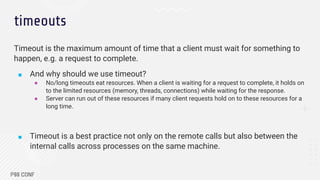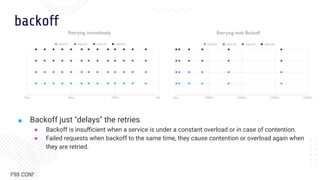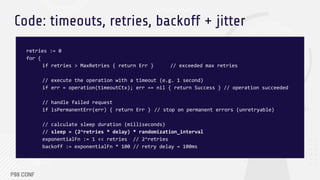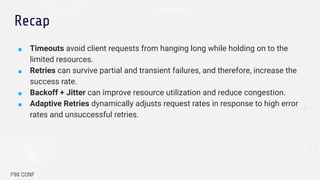The document discusses strategies for building resilient distributed systems through techniques such as timeouts, retries, backoff, and jitter to handle node failures and optimize performance. It emphasizes the importance of setting appropriate timeouts to prevent resource hogging, implementing retries for transient errors, and employing backoff with jitter to reduce contention during retries. Additionally, it introduces adaptive retries using algorithms like the token bucket to manage request rates during high error scenarios.
















![jitter
Adds randomness to the backoff (wait time) when retrying a request to spread out the load
and reduce contention.
■ What jitter to use?
Add Jitter to backoff value (most common) Between zero and backoff value
Sleep
duration
■ (2^retries * delay) +/- random_number
■ (2^retries * delay) * randomization_interval
random_between(0, 2^retries *
delay)
Resource
Utilization
less resources because work is spread out due to randomization
Time to
complete
takes longer to complete, has longer sleep durations takes less time to complete, sleep duration
min value range is 0, i.e. [0, backoff]
When to use if backing-off retries help give downstream service time to
heal
if most failures are due to contention and
spreading out retries is just what we need.](https://image.slidesharecdn.com/omarelgabryp99conf2022slidetemplate-221012154807-72439eb2/85/Square-Engineering-s-Fail-Fast-Retry-Soon-Performance-Optimization-Technique-17-320.jpg)


![Code: timeouts, retries, backoff + jitter
// … to be continued
// get a random sleep duration between interval [backoff*0.5, backoff*1.5] in ms
// for e.g. if backoff = 100ms, sleep is any number in the range [50ms, 150ms]
minInterval := backoff / 2 // backoff*0.5
maxInterval := backoff + (backoff / 2) // backoff*1.5
// rand.Intn() returns a rand number from 0 to N (exclusive) so we +1
sleep := time.Millisecond *
time.Duration(minInterval + rand.Intn(maxInterval - minInterval + 1))
time.Sleep(sleep) // wait until retry sleep duration has elapsed
retries++ // increment retries for the next retry attempt
}](https://image.slidesharecdn.com/omarelgabryp99conf2022slidetemplate-221012154807-72439eb2/85/Square-Engineering-s-Fail-Fast-Retry-Soon-Performance-Optimization-Technique-20-320.jpg)









